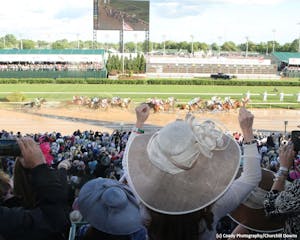When to Bet Sprinters Stretching Out in Distance

City of Light (outside) battles to victory over Accelerate in the Oaklawn Handicap - Coady Photography
Horses who stretch out in distance
Thoroughbred horse races are held over a wide variety of distances—it’s part of what makes the sport so interesting.
But as a handicapper, how do you know if a horse that has been competing in sprint races can be competitive while stretching out to route distances going a mile or farther?
Suffice to say, it can be a tricky and multi-faceted challenge, based in part on quantifiable facts and in part on intuition—but then again, the same goes for many aspects of handicapping!
The main factors to consider are pedigree and running style.
For example, a horse whose close relatives were successful running a mile or farther is more likely to achieve similar success than a horse whose ancestors were tried-and-true sprinters, though exceptions do occur.
As for running style, it’s a common belief that late runners will be more likely to handle added distance since they’re always gaining ground at the end of shorter races. But in reality, the opposite tends to be true—since sprint races usually unfold with fast paces, late-running sprinters find themselves at a disadvantage in slower-paced route races while front-running sprinters relish the slower fractions and are able to carry their speed farther.
A perfect example of this came in the 2018 Oaklawn Handicap (gr. II), a 1 1/8-mile event at Oaklawn Park. The proven route runner Accelerate was the clear favorite, but the promising sprinter City of Light figured to give him a stiff challenge… if he could handle the added distance in his first start beyond a sprint distance.
On paper, City of Light appeared to have every chance to be successful going 1 1/8 miles. His sire, Quality Road, had won multiple Grade 1 races over the distance and was already renowned as the sire of several quality route runners, including Kentucky Oaks (gr. I) winner Abel Tasman.
Furthermore, City of Light’s running style suggested that the extra distance wouldn’t be an issue. Prior to the Oaklawn Handicap, he had won the seven-furlong Malibu Stakes (gr. I) in gate-to-wire fashion and the Triple Bend Stakes (gr. I) over the same distance with a pace-tracking trip.
Even more significant, in both of those races City of Light showed the ability to maintain a strong pace over the second quarter-mile. Rather than running super-fast opening quarter-miles before decelerating in the second, City of Light had been running reasonable opening quarters in the ~:22.45 range before accelerating his second quarters in about ~:22.30, the mark of a seriously fast (but not speed crazy) runner with the potential to handle longer distances.
Perhaps because of his inexperience running long, City of Light was allowed to start at odds of 4.70-1 in the Oaklawn Handicap. Thus, when he edged out Accelerate after a long stretch battle to win by a neck, his backers were rewarded with a solid $11.40 payoff for every $2 win bet, while the logic $2 exacta with Accelerate returned $29.40.
ADVERTISEMENT



